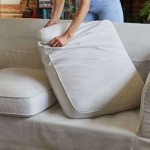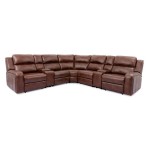How To Remove Cat Urine Smell From a Leather Sofa
Cat urine on a leather sofa presents a significant challenge for homeowners. The porous nature of leather allows urine to penetrate deeply, making odor removal difficult. Immediate and thorough cleaning is crucial to prevent permanent stains and lingering smells. This article outlines effective methods for removing cat urine and its associated odor from leather furniture, emphasizing prevention and long-term care.
Immediate Action: The First Line of Defense
The speed at which initial cleaning occurs directly impacts the success of odor removal. Fresh urine is easier to address than dried urine, which has had more time to seep into the leather's fibers and undergo chemical changes.
The initial step involves promptly blotting the affected area with clean, absorbent cloths or paper towels. Avoid rubbing, as this can spread the urine and force it deeper into the leather. Apply firm pressure to absorb as much of the liquid as possible. Repeat this process with fresh cloths until minimal moisture is transferred.
Once the excess urine is removed, ventilate the room by opening windows or using a fan. Increased airflow facilitates the evaporation of any remaining moisture and helps to dissipate the odor. The area should be allowed to air dry naturally, avoiding the use of direct heat sources like hairdryers, which can damage the leather and set the stain.
After the area is dry to the touch, a specialized leather cleaner or conditioner can be applied to help replenish the leather's natural oils and prevent it from drying out or cracking. It is recommended to test the cleaner or conditioner on an inconspicuous area of the sofa first to ensure it does not cause discoloration or damage.
Deep Cleaning Methods: Addressing Stubborn Odors
If the initial cleaning is insufficient to eliminate the urine odor, more intensive cleaning methods may be necessary. Several options are available, each with its own advantages and disadvantages.
One common approach involves using an enzymatic cleaner. These cleaners contain enzymes that break down the uric acid crystals responsible for the persistent odor. It is critical to select an enzymatic cleaner specifically formulated for use on leather. Follow the manufacturer's instructions carefully, applying the cleaner liberally to the affected area and allowing it to dwell for the recommended time. This allows the enzymes to penetrate the leather and break down the urine crystals effectively.
After the dwell time, blot the area with a clean, damp cloth to remove any residual cleaner. Allow the leather to air dry completely. Multiple applications may be needed for heavily saturated areas or older stains. Regular monitoring of the area is essential during the drying process to assess the effectiveness of the treatment.
Another method involves using a baking soda paste. Baking soda is a natural odor absorber and can help to neutralize the urine smell. Mix baking soda with a small amount of water to form a thick paste. Apply the paste to the affected area and allow it to dry completely. Once dry, vacuum the baking soda from the leather using a brush attachment. This method can be repeated as needed.
For particularly stubborn odors, a commercial leather odor eliminator may be required. These products are specifically designed to counteract the smell of urine and other organic compounds. As with enzymatic cleaners, ensure that the product is safe for use on leather and follow the manufacturer's instructions carefully. Testing on an inconspicuous area is always recommended.
Regardless of the chosen method, patience is key. Complete odor removal may require multiple treatments and several days of airing out the sofa. Regular inspection and repeated cleaning are often necessary to achieve the desired results.
Preventative Measures: Minimizing Future Incidents
Preventing future incidents is the most effective way to protect a leather sofa from cat urine. Several strategies can be implemented to discourage cats from urinating on the furniture.
First, ensure that the cat's litter box is clean and accessible. Cats are more likely to urinate outside the litter box if it is dirty or if they cannot easily access it. The litter box should be scooped regularly and cleaned thoroughly at least once a week. The location of the litter box should be in a quiet, easily accessible area, away from high-traffic areas and food and water bowls.
Second, identify and address any underlying medical or behavioral issues that may be contributing to the cat's inappropriate urination. Urinary tract infections, bladder stones, and stress can all lead to accidents outside the litter box. A veterinarian can diagnose and treat any medical conditions, while a certified cat behaviorist can help address behavioral issues.
Third, consider using deterrents to discourage the cat from approaching the sofa. These can include commercially available cat repellents, citrus scents (which cats generally dislike), or double-sided tape placed on the furniture. The use of motion-activated devices that emit a harmless spray of air can also be effective in deterring cats from accessing specific areas.
Fourth, provide the cat with alternative scratching and resting areas. Cats often urine-mark surfaces they also scratch. Providing suitable scratching posts and comfortable beds can help redirect the cat's attention away from the sofa. Rotate toys frequently to keep the cat entertained and engaged.
Finally, consider using a protective cover on the sofa, especially if the cat has a history of urinating on furniture. A waterproof cover can prevent urine from penetrating the leather, making cleanup much easier. Regularly laundering the cover can further minimize odor buildup.
Consistent attention to the cat's needs and proactive preventative measures are essential for protecting a leather sofa from cat urine. By addressing the underlying causes of inappropriate urination and implementing deterrents, homeowners can minimize the risk of future incidents and maintain the condition of their furniture.
In conclusion, removing cat urine smell from a leather sofa requires a multi-faceted approach that includes immediate cleaning, deep cleaning methods, and preventative measures. By understanding the properties of leather and the nature of cat urine, homeowners can effectively address this challenging problem and preserve the integrity of their furniture. Continued vigilance and proactive care are crucial for long-term success.

3 Ways To Remove Cat Spray Or From A Leather Couch Wikihow

3 Ways To Remove Cat Spray Or From A Leather Couch Wikihow

Remove Cat Urine Smell From Leather Couch

How To Get Cat Urine Smell Stains Out Of Leather 6 Simple Steps Catster

3 Ways To Remove Cat Spray Or From A Leather Couch Wikihow

How Do You Get Cat Out Of Leather Clearance

How To Get Cat Urine Smell Stains Out Of Leather 6 Simple Steps Catster

How To Get Cat Out Of Leather Couch Clearance

How To Get Cat Urine Smell Stains Out Of Leather 6 Simple Steps Catster

How To Clean Urine Off A Leather Couch Comprehensive Guide








